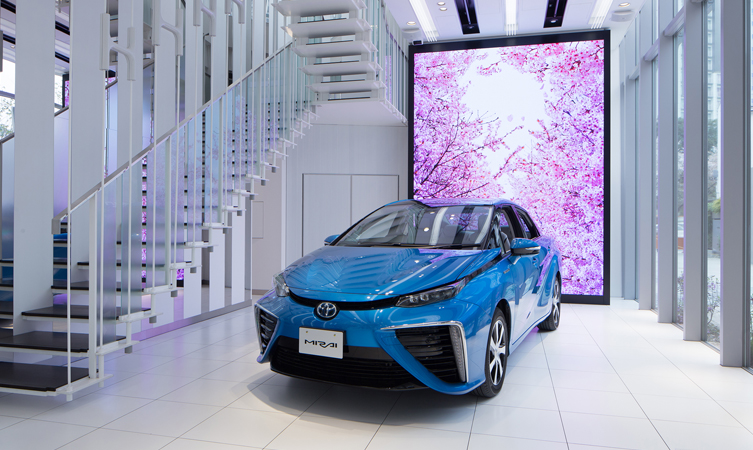As shown by its roughly half-million references in Google, Tesla’s lithium-ion cell and battery Gigafactory is a big deal.
And deservedly so.
Producing the same volume of lithium-ion cells in one building in 2020 as were produced by the whole industry during 2013 should allow substantial economies of scale for those cells--and the cars that use them.
![Tesla gigafactory: Planned 2020 production of lithium-ion cells [slide: Tesla Motors, Feb 2014] Tesla gigafactory: Planned 2020 production of lithium-ion cells [slide: Tesla Motors, Feb 2014]](https://images.hgmsites.net/lrg/tesla-gigafactory-planned-2020-production-of-lithium-ion-cells-slide-tesla-motors-feb-2014_100515392_l.jpg)
Tesla gigafactory: Planned 2020 production of lithium-ion cells [slide: Tesla Motors, Feb 2014]
But batteries won’t be the only automotive technology going through a “total global production in one building” scale-up.
This year, Toyota plans to double worldwide commercial production of Proton-Exchange-Membrane Fuel Cells, or PEMFCs.
DON'T MISS: Low-Volume Assembly Line For Toyota Mirai Hydrogen Fuel-Cell Car
Those are the fuel-cell stacks used in its 2016 Toyota Mirai hydrogen-powered vehicle, with a production of 700 cars this year. The company plans to triple Mirai production next year to 2,000 vehicles.
And those 228 MW of PEMFC’s will be more than the last three years of worldwide production combined (2012 through 2014), which European consultancy E4Tech pegs at about 210 MW in its Fuel Cell Industry Review 2014.
![Worldwide fuel-cell production in megawatts [data gathered, collated by Matthew Klippenstein] Worldwide fuel-cell production in megawatts [data gathered, collated by Matthew Klippenstein]](https://images.hgmsites.net/lrg/worldwide-fuel-cell-production-in-megawatts-data-gathered-collated-by-matthew-klippenstein_100515391_l.jpg)
Worldwide fuel-cell production in megawatts [data gathered, collated by Matthew Klippenstein]
Toyota’s fuel-cell production will reportedly stabilize at 3,000 Mirais per year (equivalent to 342 MW) until its second-generation fuel cell vehicle debuts, no doubt in time for the 2020 Tokyo Olympics.
ALSO SEE: Toyota Mirai Fuel-Cell Car To Get Global Showcase At 2020 Olympics
Given the 370 individual PEMFCs inside the Mirai fuel cell stack, this means Toyota's fuel-cell factory will soon produce about 1.1 million PEMFCs per year.
And that would make it--as Elon Musk might quip, if he weren't so opposed to hydrogen fuel-cell vehicles on principle--a Megafactory.

Toyota Mirai showroom and hydrogen fueling station, Tokyo, Japan, May 2015
Toyota has a Megafactory; so what?
True to their respective prefixes (Mega = 1 million; Giga = 1 billion) Toyota’s fuel cell plant won’t have nearly the ripple effect of Tesla’s GigaFactory.
In the near and medium term, plug-in electric vehicles will continue to outsell fuel-cell electric vehicles by margins of 100 to 1, and most likely for years to come.
Toyota’s MegaFactory won’t change that, but the surge in fuel-cell volume could put the technology on the same kind of experience curve lithium-ion batteries have traveled for the past quarter-century.

2016 Toyota Mirai construction at Motomachi plant
Even allowing for uncertainties in the data, PEM volumes don’t seem to have grown (much) in the past five years. That may indicate that suppliers haven’t been able to wring cost out through economies of scale, or justify aggressive technology development for a growing market.
The Toyota Megafactory jump-starts that growth, and should help bring costs down rapidly. Toyota itself wants to cut two-thirds to three-quarters of the cost of its fuel cells by 2020 (from about $50,000 to around $15,000).
It also means that while the 2016 Toyota Mirai ($57,500) is priced slightly below the current Tesla Model S ($75,000), its successor may be reasonably price-competitive with the planned Tesla Model 3 at $35,000.
(Retail prices for advanced-technology vehicles, of course, may not have any relationship to their production costs--especially in their first generations. Toyota has indicated that it lost money on the entire first generation of Prius hybrids, from 1997 to 2003, and only broke even after the 2004 launch of the second-generation Prius.)

2011 Nissan Leaf and 2011 Chevy Volt, with charging station visible; photo by George Parrott
Solution to lack of plugs?
None of this will be relevant to car buyers who can plug in their cars at home--they’ll almost certainly opt for electric vehicles--but lower-prices for hydrogen vehicles will be a positive for those drivers who want or need a different zero-emission vehicle, for reasons of preference or pluglessness.
A 2012 study by Axsen and Kurani estimated that only about 50 percent of U.S. households had access to even a 120-Volt electric outlet near their home parking locations.
As electric vehicles grow ever-more-compelling, one can imagine that more and more households will be willing to wire up their carports, so that plug-ins might become viable for 70 or 80 percent of new car buyers.
But home charging is unlikely to be available to every driver for many years to come, especially among those living in large multiple dwellings.
Those may be condominiums, rental apartments, or even developments run by homeowner associations that may be uninterested in letting some residents plug in.
_________________________________________________












